
“THERE’S NO CEILING FOR THIS TEAM”
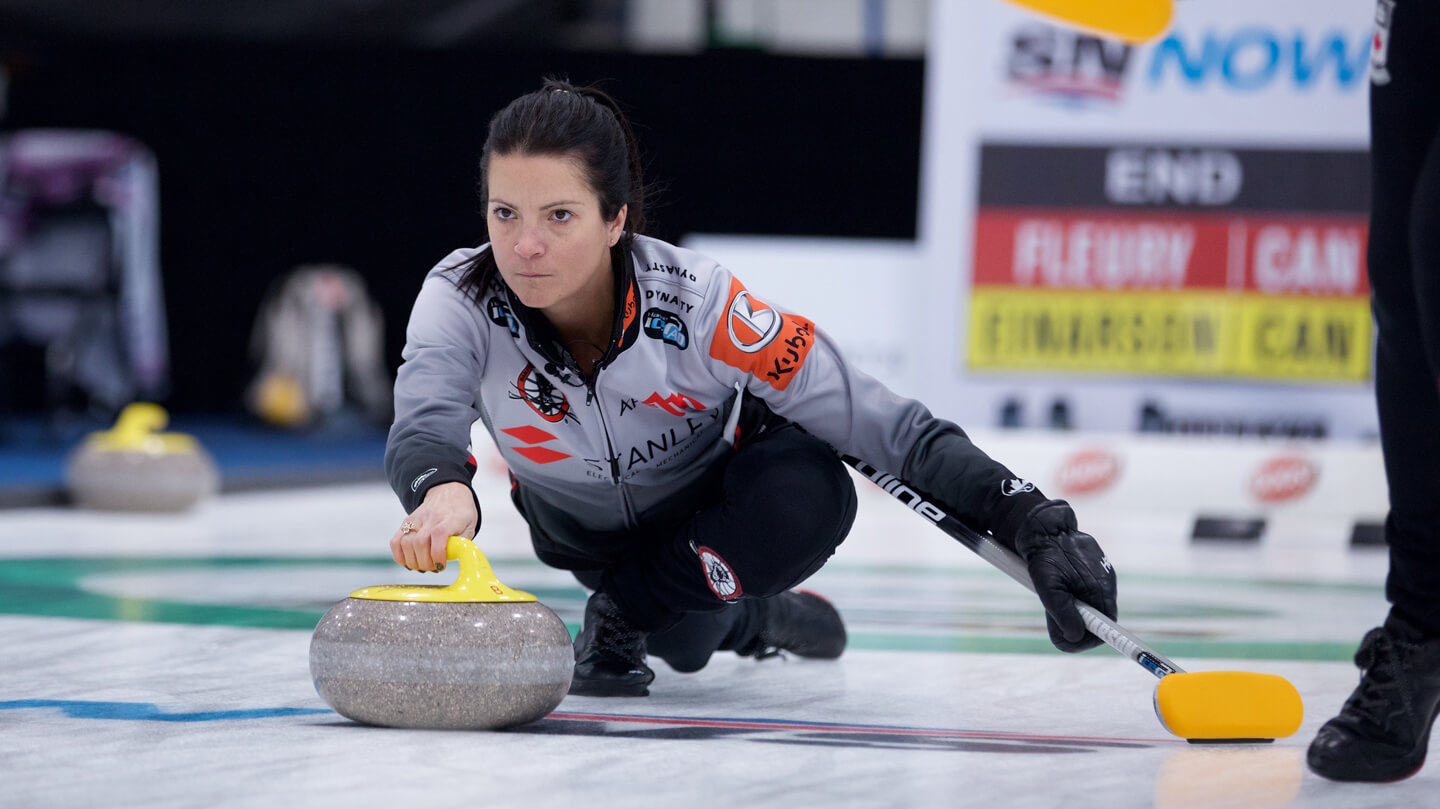
B
link while you’re driving north on Highway 8, and there’s a good chance you’ll miss Camp Morton, Manitoba. It’s on the west shore of Lake Winnipeg, and Camp Morton is tough to describe, because it’s not a city, or a town, or a village. “Road” is the most accurate way to capture the place, according to Kerri Einarson, who lives there. She laughs when asked how many other people call Camp Morton home, and then excuses herself from the phone for a second. “How many people in Camp Morton?” Einarson asks her husband, Kyle. “Ballpark.”
Well, there are four people in their house alone, rounded out by their eight-year-old twin daughters, Kamryn and Khloe. After a chat with Kyle, Einarson reports back: “Maybe 50,” she says. The idea that there might be a sheet of curling ice or a store there makes Einarson laugh again. “No, nothing like that,” she says. “Way back in the day, there used to be a store on the corner, but not anymore. Now Camp Morton’s basically just a main road that divides two major highways.”
But if by chance you don’t blink as you drive past, you’ll see a sign that features a couple of curling rocks and the words: “Home of Canadian champion, Kerri Einarson.” It went up in 2021, and it was supposed to be a surprise, “but a neighbour spilled the beans,” Einarson says.
By the time that new sign was hammered into the ground, Einarson had skipped her team of Val Sweeting, Shannon Birchard and Briane Meilleur to back-to-back Scotties Tournament of Hearts titles, in 2020 and 2021. And then in February of 2022, Team Einarson managed the three-peat. It’s only the fifth time in history a men’s or women’s team has pulled that off in this country’s deep and world-class field. Alberta’s Randy Ferbey, Manitoba’s Jennifer Jones and Saskatchewan’s Vera Pezer all led their foursomes to three straight, while Nova Scotia’s Colleen Jones led a team to four. Einarson’s crew could match that high-water mark in 2023, but they’re already in the finest of company. “What they’ve done, it’s almost unheard of,” says a wide-eyed Jeff Stoughton, the three-time (though, not in succession) Brier champion. “And I think it hasn’t gotten the public recognition that it deserves. Like, this is frickin’ huge.”
This frickin’ huge accomplishment slipped under the radar because Team Einarson achieved most of its success during a pandemic. As a result, they’ve had fewer opportunities to represent Team Canada than they rightfully earned. But as the rink heads into this week’s Grand Slam of Curling event with an eye on defending the Players’ Championship they won in Toronto a year ago, they’re in a well-deserved spotlight, fresh off a bronze medal performance last month at world championships — the first time since 2018 that Canada’s women have stood on a world podium. And it’s about time Meilleur, Birchard, Sweeting and Einarson got their shine. Led by a skip with a personality coach Reid Carruthers describes as “piss and vinegar,” these women took a risk to play together, changing their roles on the ice so that they could. And while nearly every top-ranked rink has announced they’re breaking up at the end of this season to start fresh and push towards the next Olympics, Team Einarson is sticking together to build on their success. Theirs is not a team you can blink and miss.
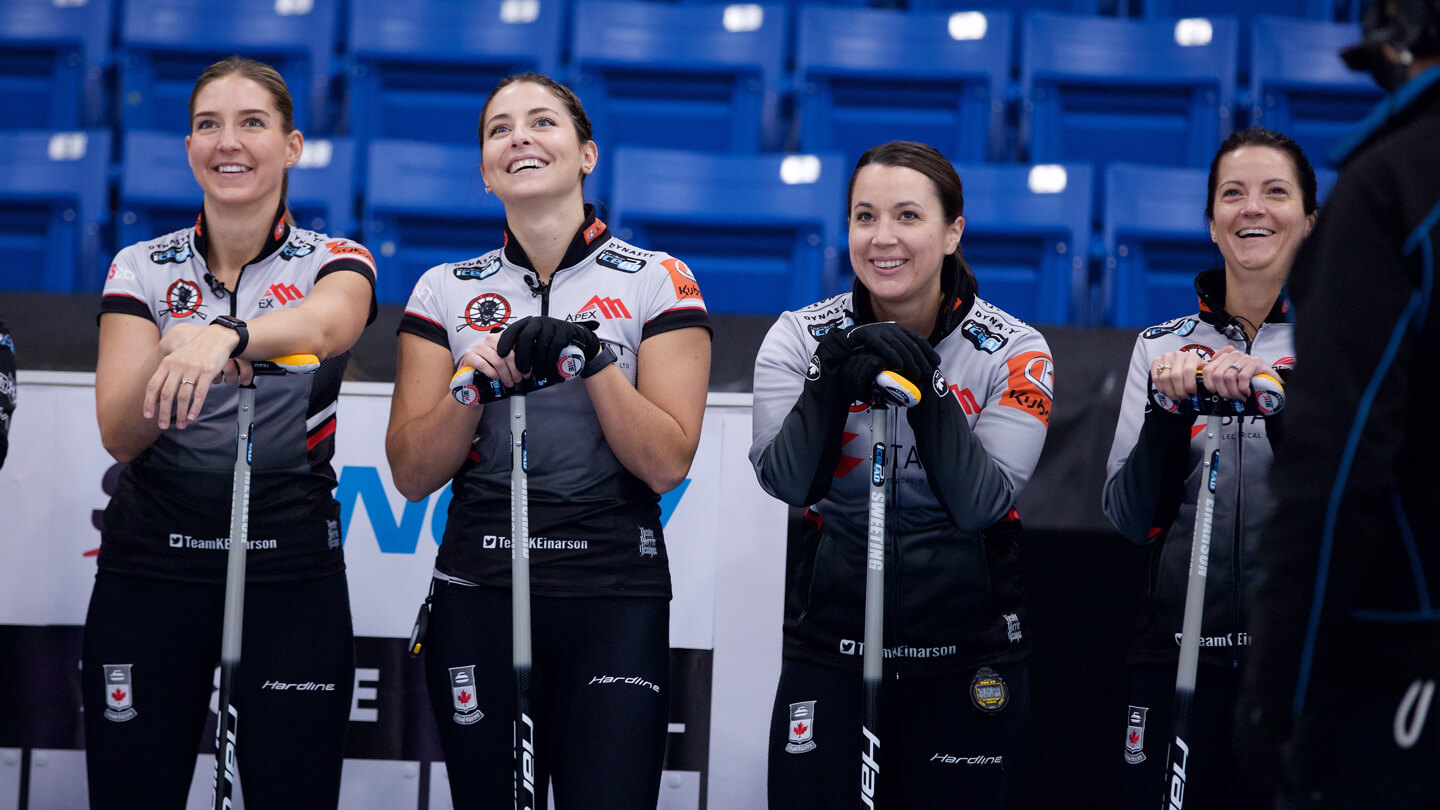
K
erri Einarson is incredibly frickin’ huge among a very loyal fanbase of people in their 80s, or thereabouts. When the petite 34-year-old with pin straight dark hair and a dialled-in on-ice gaze is competing, nearly every television at Betel Home Foundation in Gimli, Man., is locked on curling. The residents there don’t miss games featuring the skip who’s also a rehabilitation assistant at their facility. They cheer Einarson on. They FaceTime her to ask: “When are you coming back to work? We miss you!” And they never hesitate to share their thoughts on her game after a big event.
“Oh, I get tips — all the time,” Einarson says, laughing. “Or they’re like, ‘Kerri, why did you play that shot? You guys have gotta pick it up!’ I’m like, ‘Okay, I know…’ They’re always givin’ me the gears.”
Einarson’s work at the facility includes helping residents maintain their mobility, and getting them up and out of their wheelchairs for frequent walks. Her voice softens as she tells the story of a woman who recently broke her hip, then recovered and was able to walk on her own. “They’re honestly all so amazing. I love my work. I love going in every day, and not everyone can say that,” Einarson says. “They all feel like my grandparents. And we always have such good chats about curling.”
The Betel Home is fewer than two kilometres from the Gimli Curling Club, which Team Einarson calls home. And it’s just south of there, in Petersfield, that Einarson got her start in the sport. She began curling at age eight, in part because her mom regularly hit the ice. But what started her thinking about the competitive side was watching her uncle Greg McAulay skip his B.C. rink to a Brier and a world championship title when she was 13. “That was who really got me motivated,” Einarson says.
It was right around that time that her older brother, Kyle, also started curling, a sport he’d avoided before then because “he didn’t think it was cool,” Einarson says. World champ Uncle Greg probably helped change Kyle’s mind. Einarson fondly remembers skipping a team one sheet over from the team her brother skipped while they were juniors. They both won big games that day, and high-fived afterwards.
Just a year apart in age, Kerri and Kyle were coming up together in curling, and the sibling rivalry was real. But then, Kyle was killed in a snowmobiling accident. He was 20 years old. “It was extremely hard,” Einarson says. “It happened right before we had provincials, and I wasn’t going to play, but I knew he would still want me to.” Curling was a bond they’d shared, after all, and it helped Einarson cope. She keeps a locket with her during games that contains a picture of her brother, in mid golf swing. “I still think of him every time I step on the ice,” she says. She figures they’d be playing mixed doubles today, if they could.
Einarson continued to work hard in curling, fuelled by her passion for the game and the memory of her brother. But as she continued to ascend the ranks of junior curling, Einarson found herself losing a lot of semifinals in the hotbed that is Manitoba. “I was getting very discouraged in my junior years,” she says. “I was trying to find the right four girls with the same commitment level, and trying to get over that hump to win.” She’s seven years older than Birchard, but the two played against each other near the end of Einarson’s junior career. “She was just this all-around, hugely talented player,” Birchard says. “Such a shooter.”
Einarson was recruited to skip a senior team out of juniors, and in her first women’s-level provincials, she helped the rink to a 4-3 record. A few years later, she put together her own foursome, and in 2016 — after back-to-back losses in provincial finals — Einarson broke through and won Manitoba for the first time. “To finally get to wear the Buffalo was unbelievable,” she says.
Two years later, Einarson qualified for her second nationals. And at that 2018 Scotties, another major milestone occurred: She beat fellow Manitoban Jennifer Jones for the first time. “It was absolutely unbelievable. Like, monkey’s off my back!” Einarson says. “It only took me 20 tries to beat her, but I got it.” It took a long time for a few reasons, Jones’s incredible skill high among them, but Einarson believes one key for her was having the right mix of players. “You’ve got to get four people who are committed and are on the same level,” she says.
Einarson lost in the Scotties final that year — to Jones, no less. At the end of that season, Einarson’s team broke up, and she focused on finding the right players to get herself back in the final, but change the outcome. To do that, she decided to go an unconventional route, with others who were willing to do the same.
“I thought to myself: ‘I’m taking a big chance here,’” she says. “’Let’s hope this pays off.’”
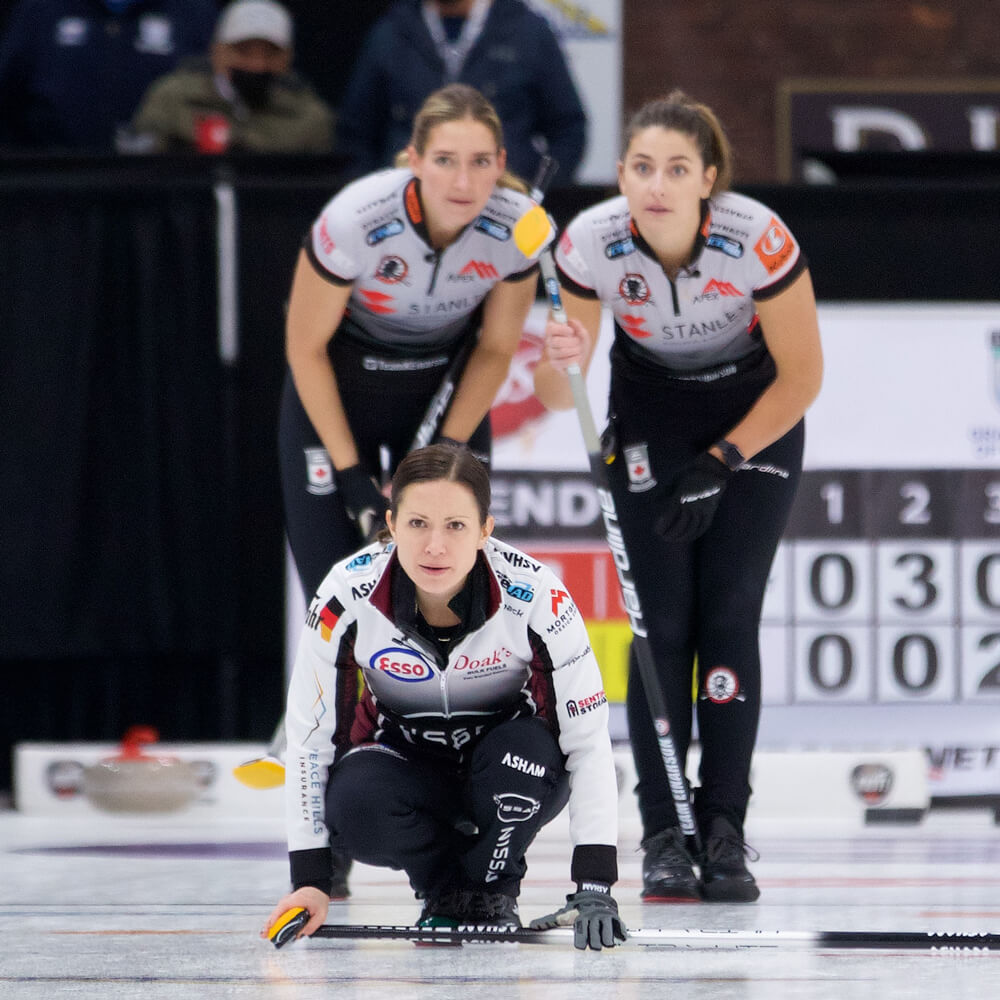
T
he announcement went out ahead of the 2018-19 season, right around the time all teams are making their roster decisions known. Einarson would skip a new team. Skip Val Sweeting would play third. Skip Shannon Birchard would slot in at second. And skip Briane Meilleur would play lead. “We heard from the peanut gallery,” Birchard says. “That lot from afar.”
Curling fans sure were skeptical about this new team made up of skips, a “super rare” move in elite curling, as Sweeting puts it. “People had doubts about whether we could actually do what we set out to do,” Birchard adds. “That was something we wanted to prove to everybody — but mostly to ourselves — that we had made the right decision in coming together and trying something new.”
“Four skips together?” Einarson says, raising her voice, parroting the query she heard more than a few times. “Really? Do you think that’s gonna work?”
She had an idea it just might. At the tail-end of the 2017-18 campaign, Meilleur and Birchard had reached out, wondering about her plans for the following season. In Birchard’s case, she had just won the 2018 Scotties while playing third for Jones — beating Einarson in the final. (Birchard was filling in for Jones’s usual third, Kaitlyn Lawes, and had been skipping her own team that season.) Then Sweeting reached out and said her Alberta-based foursome were going their separate ways. She had just come one win short of qualifying for the 2018 Olympics in mixed doubles, with Brad Gushue. “I was not in a good place,” Sweeting says now. She had twice lost in the Scotties final, and Gushue says the loss at Olympic trials made him feel far more upset for her than for himself. “Val was kind of that perennial runner-up,” he explains. And so, a fresh start with Einarson had a lot of appeal. “It’s tough to get over being one game away from the Olympics,” Sweeting says. “Something new, and being more of that supportive role and a third, it was something I was definitely open to.”
Einarson floated the idea of Sweeting as the team’s third, and the wheels began turning. “Briane was like, ‘Oh, so I would play lead?’ Briane’s a very good touch player, and she would make those clutch draws when you need it,” Einarson says. “And Shannon, she’s a great hitter, she makes those big-weight shots and also has a really good touch game. I knew she would be a great second. They’re both really tall and strong and dedicated, so I knew they’d make great sweepers. I thought it all through and we brought Val on — she’s so smart, knows so much about the game, and makes so many clutch shots when we need them. I definitely thought this could really be a hit.”
Sweeting, Birchard and Meilleur all put their trust in Einarson to play the position they’d once played themselves. “I admired Kerri’s ability to always be in it — and she was knocking at the door for a really long time,” Birchard says. “In those couple years leading up to when we got together, she was really starting to peak. I wanted to grab onto that and get the chance to play with her and learn from her. She’s got so much fight in her.”
When he began coaching the team earlier this year, Carruthers noticed that spirit immediately. “She brings a lot of fire to the table,” he says. “When she’s out there competing, she just wants it. Even in practice, she’s fired up, trying to make every shot [and]mad if she misses one.” Adds Gushue, who has teamed up with Einarson in mixed doubles: “I love her intensity.”
It takes a special personality, too, to manage a team of skips. “There’s not a lot of skips out there that could take as much input from the three of us as we give sometimes,” Sweeting says. “But Kerri always welcomes it.”
“The girls, they had so much faith in me, and it was amazing that they could step down and let me take the reins,” Einarson says. “They did and they embraced every role, really embraced their positions.”
The team played a lot that first season, in part wanting to earn enough points to qualify for the Grand Slams, which they did. “We were eager to make things work and be successful right off the hop, and I think that meant getting in as many reps as possible and making our mark,” says Birchard. And make their mark they did: Team Einarson won its first four events on the World Curling Tour. “It was unbelievable,” Sweeting says. “I was like, ‘Wow, what’s going on? I’m used to just losing in finals.’”
“I think we honestly surprised ourselves in the beginning,” Birchard adds. “It was more success than any of us had any experience with to start off a season. We had so much energy and so much passion towards learning about our new positions that I think that really also propelled us forward.”
That season, they lost the Canada Cup final, won a Grand Slam Event — the Players — and lost in another Grand Slam final, the Champions Cup. “I think we made like 10 finals,” Sweeting says. “I mean, we definitely came out of the gates pretty hot.”
Despite all the success, though, the big goal for the season wasn’t met: The team lost in the wildcard game and didn’t qualify for the Scotties out of Manitoba (the world’s top three Canadian women’s teams are all from that province).
In 2020, Einarson, Sweeting, Birchard and Meilleur made good on their No. 1 goal and qualified for their first national championship together. “We had a little something to prove still to curling fans and doubters that thought our team wouldn’t be able to work,” Birchard says.
The Scotties was in Moose Jaw, Sask., in the same venue that had hosted in 2015, where Sweeting had lost in the final for a second straight year. Once again, she found herself in the final, this time up against Ontario’s Team Homan. “I just remember being scared of losing again,” Sweeting says. “I was so nervous.”
Team Homan and Team Einarson were tied in the 10th end, and Einarson had the hammer and a draw to the button for the win. But as soon as that stone left her fingers, she knew it was heavy. The game was going to an extra end, and Einarson apologized to her team and immediately reset. “I took a deep breath and I was like: ‘Kerri, you got this,’” Einarson says. “‘Bring your sweepers into play. Make it a team shot.’”
“Everybody was so emotional, but Kerri was extremely emotional, you could see it on her face,” Birchard says.
“Watching it back, I look like I’m going to bawl my eyes out,” Einarson admits.
“But she was so good — so good — at taking a step back and calming herself down and resetting and refocusing for those big moments,” Birchard adds. “We had every belief in her throughout that game. We knew, ‘Okay, Kerri’s probably going to have a draw for the win.’”
Einarson did, and she nailed it on her second try. “It was lots of emotions and ugly cry face after,” Sweeting says. “Relief, excitement, happy tears, all of it.”
The team celebrated with family at Boston Pizza, then headed back to the hotel, where they popped champagne and laughed and chatted and listened to music in a conference room. It was a late night, a moment they all wanted to soak up, one that was a long time coming for the team’s skip and third. “Val and I had lost in the finals, so it was hard, and she and I were like, ‘Are we jinxing it?’” Einarson says. “That was a really special breakthrough.”
That monkey was off their backs. And the team has been perfect at the Scotties ever since.
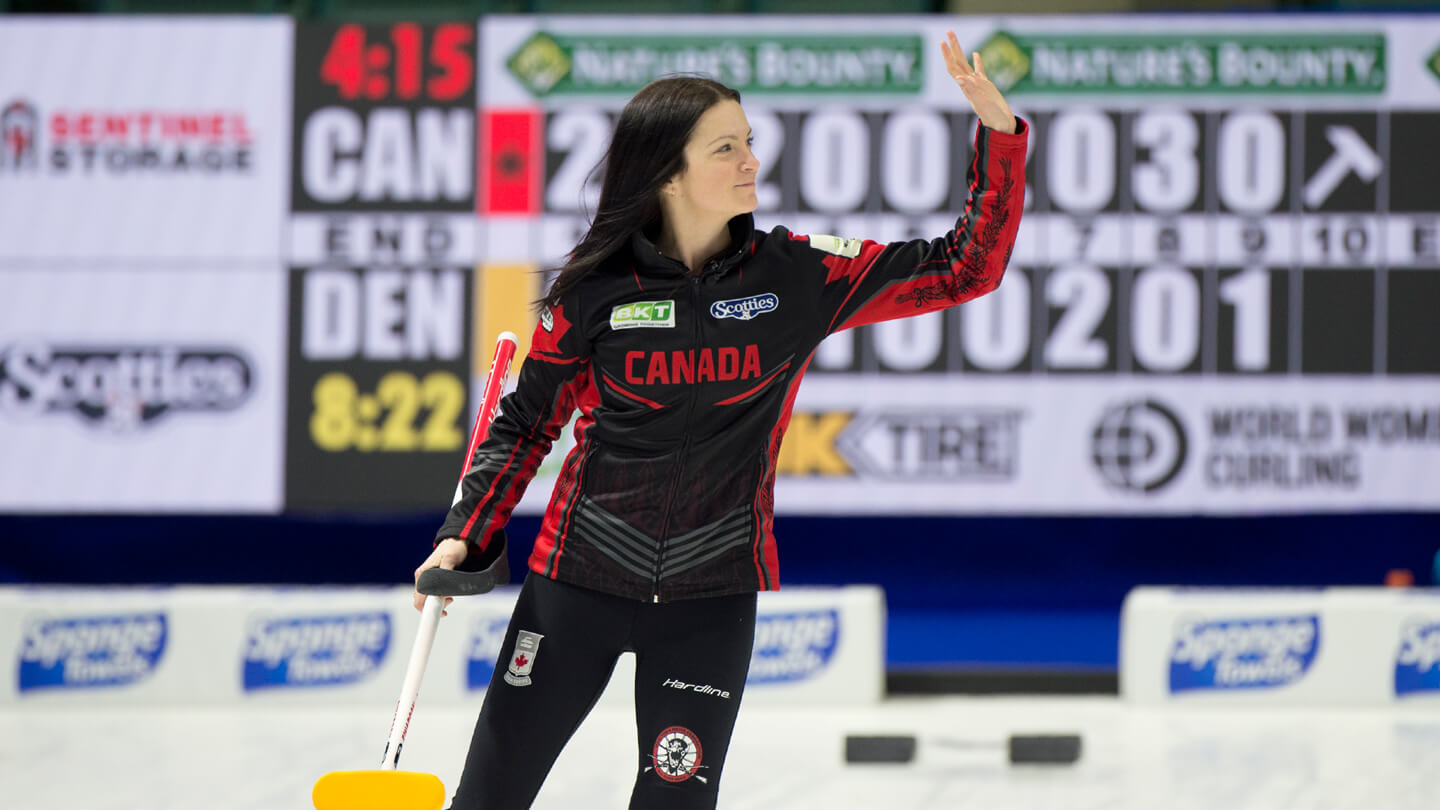
I
t was the stuff of childhood dreams: A world championship on home ice; a chance to wear Team Canada jerseys in front of a home crowd. Einarson, Sweeting, Birchard and Meilleur arrived in Prince George, B.C., a few days before their first game at the 2020 World Championship. They got groceries and stocked their rooms’ mini fridges. They practiced. “The excitement was so high,” Sweeting says. And then came the news: Leagues all over North America were cancelling their seasons because of COVID-19.
Since all the teams had already arrived for worlds, players held out hope that the tournament would go on. But the next morning, Einarson saw a notification pop up on her watch, breaking news from social media. “I looked down and it said ‘Women’s worlds cancelled.’ I was like, ‘What?’” she says. The four members of Team Einarson cried together in one of their hotel rooms. That afternoon, the team went to the arena and played a game against some of the volunteers and media still on site. They flew home the next morning.
“That was devastating, because you don’t know if you’re going to win the Scotties again — it’s so rare,” Sweeting says. “You finally break through and you never imagine that you’re not going to get to play in the world championship. At that point I remember thinking: ‘Well, they can’t just not have the women’s worlds. They have to have it at some point, right? They have to replay it.’ But they never did.”
Receiving their Team Canada jerseys was “something you dream of as a kid,” Sweeting says, but theirs turned up just after they heard the event was cancelled. She cried, knowing she wouldn’t be wearing it for a game, and she couldn’t bring herself to put it on until a couple weeks later. When Sweeting did eventually wear it, it was only for a social media post to recognize the work of designer Kevin Hurrie and Dynasty Curling. “I wanted to honour that, but it was definitely tough, just looking at it and wearing it after that,” she says.
The following curling season saw a host of events cancelled, and others held in a bubble in Calgary. It meant teams spent months away from their families, lived in a tight quarantine and competed in an empty arena. Team Einarson repeated the win at Scotties, again over Team Homan, but at that point the world championship wasn’t scheduled. “We thought, ‘Oh, we’d be the only team to win two Scotties and never play in worlds,’” Sweeting says, with a laugh. “Great.”
The 2021 world championships did go on, in that Calgary bubble. Team Canada started out 1-5, but clawed their way back to a 7-6 record and squeaked into the playoffs, though the Canadians were eliminated by Sweden in the qualification game.
“It was emotionally draining,” Einarson says. The team was able to go outside only for walks, and competed without the presence of friends and family and fans.
When Einarson got home to Camp Morton, she barely saw the inside of her home. If she wasn’t sleeping, Einarson was out somewhere on her family’s 167-acre lot. “I didn’t want to spend any time inside,” she says. “I was washing the car, going for bike rides with the girls, I was mowing the lawn, doing whatever I could outside. My husband was like, ‘Are you gonna come inside, ever?’ I said, ‘No, I feel like I’ve been in jail for a long time and I don’t want to be trapped in four walls again.’”
Suffice it to say, Einarson and her teammates didn’t get the true Team Canada experience — for the second year in a row.
“We were just getting used to bad news, you know?” Einarson says.
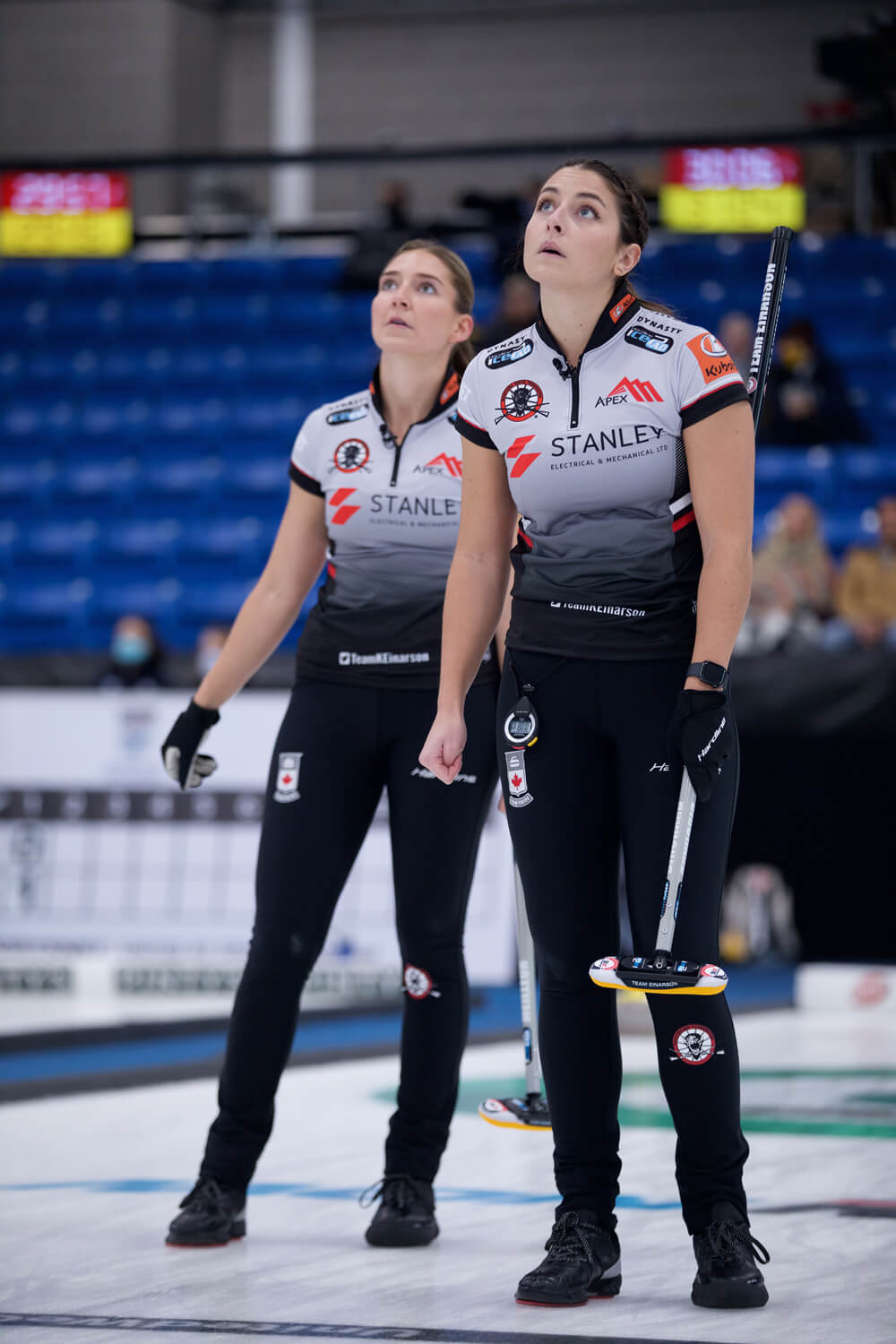
W
e Will Rock You” blared over the arena’s speakers, while fans stomped their feet to the beat in Prince George. As Sweeting headed back to the ice after the fifth end break during her team’s opening game of the 2022 world championship — an eventual 9-6 win over the Czech Republic — she broke out in goosebumps as she listened to those pounding feet. “I would take a minute and just think: ‘It’s so cool to be here and have this opportunity to represent Canada in front of fans.’ It was a dream come true,” Sweeting says, recalling in particular the way the fans erupted after a big shot. “When you think it’s going to happen two years ago, and a year ago, and then it finally happens, it’s extra special.”
Adds Einarson, of the crowd’s reaction to big shots: “I will never, ever forget that feeling.”
Any feelings of déjà vu the team had being back in Prince George quickly dissipated after they arrived in March. And though both Scotland and Japan were forced to withdraw due to COVID cases on their teams, the Canadians stayed upbeat and focused on the event, controlling what they could. In the semi-final, up 6-4 against Korea, Team Einarson failed to score in the final three ends, and had to settle for a loss. It meant regrouping for a bronze medal game the next morning against the Swedes, who’d won Olympic bronze a month earlier.
“The bronze game is tough, but we definitely wanted to bring home a medal. We knew how much that would mean to us, and to Canada,” Sweeting says. The team thought about the experience of Team Gushue at the Olympics, having to regroup after tearfully losing in the semi-final, and then going on to earn bronze. “I knew we would be proud to get that medal, too,” Sweeting says.
The game came down to the final stone, and an extra end.
“As soon as I released the rock, I knew it was really close,” Einarson says. “The fans started chanting — and it wasn’t too loud, and as soon as the rock made contact, Val threw her arms up in the air. It wasn’t the celebration you’d normally see for gold, but it was still so special.”
Einarson’s eyes welled with tears as she looked into the crowd, at Kyle and Khloe and Kamryn and her parents and a bunch of aunts and uncles and cousins. She celebrated with her teammates while the fans roared. “To actually feel like Team Canada was amazing,” Einarson says. “That was the first time we truly did.”
“I just try to tell myself everything happens for a reason,” Sweeting adds. “If we hadn’t gone through all those disappointments, would we be where we are now?”
Where they are now is in rare company. Gushue, winner of four Brier titles, jokes that two of his former mixed doubles partners, in Einarson and Sweeting, are “getting greedy, winning three in a row.”
Coach Adam Kingsbury, who’s worked with Einarson on the mental side of the game, says there’s no reason that streak of national titles has to stop. “She’s figured out a way to get herself in those big moments and I think now she really believes in herself,” Kingsbury says. “I just think, why not six [Scotties titles] in a row?”
Well, it’s certainly possible. The team got together for a training camp in Winnipeg prior to world championships, and decided then that they’re staying together for another four years. The big goal is to represent Canada at the 2026 Milano Cortina Olympics, after coming up short in qualification for Beijing earlier this year.
“We’re not done,” Birchard says. “There’s no ceiling for this team, and we want to keep pushing and see what we can do together.”
The one skip on this team who’s still a skip has an idea of what that could look like with Sweeting, Birchard and Meilleur. And after the trying and complicated run to get to this point, the goal is actually pretty simple, if you ask Einarson: “We all still want to become the best there is.”
Anil Mungal/GSOC (3); Michael Burns/Curling Canada; Anil Mungal/GSOC.




